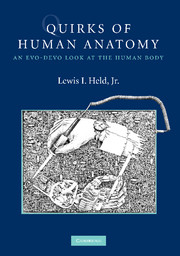Book contents
- Frontmatter
- Contents
- Preface
- CHAPTER 1 BACKGROUND
- CHAPTER 2 SYMMETRY AND ASYMMETRY
- CHAPTER 3 MYSTERIES OF THE MIDLINE
- CHAPTER 4 MERISM AND MODULARITY
- CHAPTER 5 SEXUAL DIMORPHISMS
- CHAPTER 6 SILLY, STUPID, AND DANGEROUS QUIRKS
- CHAPTER 7 MIND AND BRAIN
- EPILOGUE
- APPENDIX: QUIRKS OF HUMAN BEHAVIOR
- References
- Index
CHAPTER 5 - SEXUAL DIMORPHISMS
Published online by Cambridge University Press: 05 August 2012
- Frontmatter
- Contents
- Preface
- CHAPTER 1 BACKGROUND
- CHAPTER 2 SYMMETRY AND ASYMMETRY
- CHAPTER 3 MYSTERIES OF THE MIDLINE
- CHAPTER 4 MERISM AND MODULARITY
- CHAPTER 5 SEXUAL DIMORPHISMS
- CHAPTER 6 SILLY, STUPID, AND DANGEROUS QUIRKS
- CHAPTER 7 MIND AND BRAIN
- EPILOGUE
- APPENDIX: QUIRKS OF HUMAN BEHAVIOR
- References
- Index
Summary
The key lesson from the previous chapter is that no member of a meristic series (finger, tooth, vertebra, etc.) can deviate appreciably in its anatomy until it acquires a distinctive identity. Identities are conferred by the ON/OFF states of selector genes that encode transcription factors.
Once a member(s) of an array does come under the jurisdiction of its own selector gene(s), a new “compartment” can form within the genome. If the selector gene later captures a target gene(s) that affects local growth, then this body part can attain a unique size and shape (cf. Fig. 4.2).
Why do men and women differ in size and shape?
From the standpoint of our genome, the states of the system that we call Man and Woman are operationally no different from Thumb, Canine, or Sacrum. They're just other compartments [885, 1392, 1393] without the meristic trappings [151]. In short, men and women differ in anatomy for the same reasons that our thumb differs from our forefinger: (1) they employ different selector genes, and (2) those regulatory genes control different sets of downstream genes that directly affect size and shape.
The sexual equivalent of the “grotesque mosaicism” seen in some meristic patterns (cf. Figs. 4.1–4.7) would be a disparity so dramatic that the two sexes look as if they belong to separate species. Gorillas are a good example within the primates [1361, 1667], and it is not hard to find similar cases in most animal groups [71, 962, 1315, 2079, 2370].
- Type
- Chapter
- Information
- Quirks of Human AnatomyAn Evo-Devo Look at the Human Body, pp. 75 - 104Publisher: Cambridge University PressPrint publication year: 2009



